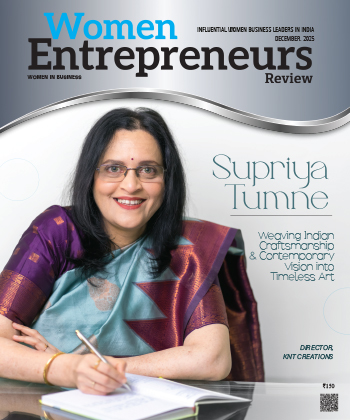
Revolutionizing Clean Energy: Women at the Forefront of India's Green Transition
By: Dhanya Rajeswaran, Country Managing Director for India, Fluence
Dhanya Rajeswaran is the Country Managing Director for India at Fluence, a global market leader delivering intelligent energy storage and optimization software for renewables and storage. She leads Fluence's Global Innovation Center in Bangalore, a key innovation hub that is driving the company’s transformation. With extensive HR leadership experience across sectors, Dhanya has scaled businesses in APAC, championed innovation, and fostered inclusivity. A GALLUP strengths coach and Six Sigma Black Belt, Dhanya also serves on various advisory boards, reflecting her commitment to diversity.
In a recent conversation with Women Entrepreneurs Review Magazine, Dhanya shares her insights on the clean energy sector for women in India, discussing milestones in gender diversity, fostering collaboration between organizations and women leaders, and overcoming obstacles as a woman team leader in a traditionally male-dominated industry.
Could you share some insights about the current landscape of the clean energy sector for women in India? Which milestones have we reached with regards to gender diversity and inclusion?
A 2019 joint study by the International Energy Agency (IEA) and the Council on Energy, Environment and Water (CEEW) revealed that women account for an estimated 11% of the workforce in the rooftop solar sector in India. This is significantly less than the global average of 32% as per a 2018 survey by International Renewable Energy Agency (IRENA). However, the clean energy sector in India offers a unique opportunity to bridge this gap, particularly as more women enter core fields of study like engineering, technology, and environmental science. These are essential areas for driving innovation in the renewable energy sector, and we are seeing a slow but steady shift towards a more inclusive workforce. Empowering women in this sector isn’t just a matter of equity; it's a substantial economic opportunity. According to the McKinsey Global Institute, achieving gender parity could contribute an additional $3 trillion to India’s GDP by 2025.
Initiatives like the Women’s Empowerment Scheme and inclusive hiring practices in the private sector are helping to ensure that women play an integral role in India’s clean energy future. While industry-wide figures show room for growth, Fluence has made intentional efforts to champion diversity. Since its inception in India three years ago, Fluence has focused on fostering a culture that welcomes women and supports their professional growth. This is reflected in the policies, infrastructure, and cultural acceptance designed to empower women to contribute meaningfully. At Fluence’s Global Innovation Center in Bangalore, for example, women make up 20% of the team—a conscious decision driven by the understanding that diverse perspectives are crucial for innovation and sustainability. Globally, Fluence is home to many women leaders, from product development to operational roles, who serve as role models for young women entering the workforce. Here, gender diversity is not just a goal, but a fundamental principle woven into the fabric of our operations.
Collaboration and partnerships are essential for driving sustainable change in the clean energy sector. How do you envision fostering greater collaboration between organizations and women leaders to accelerate progress towards a more inclusive and sustainable energy future in India?
The clean energy transition is a complex challenge that requires the collective efforts of an entire ecosystem—no single entity can solve it alone. Collaboration, both across organizations and among women leaders, is crucial to creating a more inclusive and sustainable energy future in India.
First, partnerships between industry and academia are essential. We need to ensure that engineering curricula emphasize renewable energy and sustainability, preparing future leaders to tackle challenges like energy storage and grid stability.In the past few years, there has been significant emphasis on IT and related fields, but we now need a greater focus on subjects relevant to the renewable energy and power sectors.
Second, supply chain diversification is crucial. India’s rich human resources must be paired with local manufacturing capabilities to reduce dependency and also boost self-reliance. Women leaders can drive this effort, focusing on resilience and local innovation, contributing to a more diversified and robust clean energy ecosystem.
Third, industry collaboration is key. The challenges we face, from energy storage to grid integration, are common across the sector. Sharing insights and solutions across organizations will help guide India’s clean energy trajectory.
Lastly, sustainable battery solutions are critical. We need to invest in creating a circular economy for batteries, ensuring their adoption is both widespread and environmentally responsible. Here,too, collaboration between corporate leaders, manufacturers, and policymakers will be vital.
Despite the progress made, there still exist barriers and obstacles that hinder women's advancement in traditionally male-dominated industries. What are some of the most significant obstacles that you have encountered as a woman team leader in the clean energy industry? How have you overcome these roadblocks?
Challenges in leadership are universal, regardless of gender. Whether male or female, every leader faces obstacles related to being heard, having expertise recognized, and driving change. However, for womenin clean energy sector, the path can often feel lonelier due to the underrepresentation of women in leadership roles.
While networks and mentorship opportunities for women does exist, it is still less prevalent than those available to men. Men often benefit from informal networks that help them advance, while women need to be more intentional in seeking out these support systems. That said, with the right networks and mentorship in place, women can navigate leadership challenges just as effectively.
The key is building inner confidence and having a deep command of your subject. Leadership, at its core, is about solving problems—whether managing a team, navigating complex projects, or driving innovation. In this respect, gender does not need to define success. It's about how effectively you can focus on the task at hand and push through challenges with determination and resilience.
The clean energy sector is rapidly evolving, with new technologies and innovations shaping its trajectory. How do you stay ahead of these changes? What can women leaders do to align themselves with the evolving needs of the industry, in order to stay ahead of the curve?
Staying ahead in the clean energy sector requires foresight and a clear vision of what the future looks like in a net-zero world. The key is to envision that future and break it down into actionable steps for today. Since the path to net zero is largely uncharted, what matters is having clarity of purpose and direction.
Leaders must stay updated on the evolving global landscape, engage in conversations with people who offer diverse perspectives, and courageously experiment with creative solutions. Sometimes, solving problems in clean energy requires fresh insights from experts in completely different industries. The ability to reimagine how to solve these challenges stems from having a creative and expansive vision that goes beyond traditional industry boundaries.
What are some of the major benefits women bring to leadership roles in the clean energy sector, and how can organizations utilize those different qualities to promote innovation and growth even more?
Women often bring a long-term, sustainability-focused perspective to leadership, which stems from their natural role as nurturers and protectors of the future. This far-sighted approach encourages broader thinking in decision-making and creativity, especially on critical topics like enabling practical and sustainable solutions in energy storage. This broader lens is essential in the clean energy sector, where sustainability directly impacts ROI.
Secondly, the renewable energy sector sees technologies evolving rapidly. This is an industry filled with trial and error and women leaders tend to nurture a supportive environment that allows teams to fail fast and learn quickly.
The powerful combination of a sustainability mindset with a nurturing leadership style can make women leaders stand out when it comes to fostering innovation and driving growth in the rapidly evolving clean energy field.
What role do you see women playing in driving future advancements and disruptions within the clean energy industry?
Both men and women will play significant roles in driving future advancements within the clean energy industry, as the sector's success relies on diverse perspectives and contributions regardless of gender. However, women are becoming increasingly prominent, particularly as more women are staying in the field and pursuing technology-driven career paths. Historically, sectors like manufacturing have seen women drop off, but in clean energy, there’s a positive shift where women are committed to contributing to the energy transition. This signals a future where more women will hold key decision-making positions as the industry evolves.
A strong focus is needed on ensuring that women remain in core, technical roles, as building a solid foundation in engineering and science is crucial to solving real-world problems and driving innovation. While both men and women bring unique strengths to the table, the industry must prioritize inclusion, particularly in leadership roles, to ensure diverse insights and approaches that will shape the future of clean energy.
Most Viewed
- 1 Women's Health Startup HerMD Closing Doors Amid Industry Challenges
- 2 5 Famous Women in Indian Armed Forces
- 3 Saudi Women No longer Require Male Permission for Clothing Choices, says Prince MbS
- 4 Kolkata Medtech Startup Innovodigm Raises Rs 5.5 Crore Seed Funding Led by IAN Group
- 5 Yamunanagar's Kashish Kalra Honoured after Securing 111th Rank in UPSC Civil Services Exam
- 6 Madurai Appoints Its First Woman Corporation Head
- 7 IAS Vijayalakshmi Bidari Appointed as the new Nagpur Divisional Commissioner
- 8 American Entrepreneur Lucy Guo Overtakes T Swift to become Youngest Female Billionaire
- 9 ICC Women's World Cup 2025 Trophy Showcased at Indore's Holkar Stadium
- 10 Aparna Saxena's Beauty Venture AntiNorm Launches in India
- 11 Vidya Nataraj Co-Founded BlueStone Jewellery & Lifestyle files IPO
- 12 5 Women Freedom Fighters of India
- 13 Dr. G Krishnapriya appointed as CEO for Trichy
- 14 M3M & Sirona Partner to Introduce Menstrual Hygiene Vending Machines in 15 Locations
- 15 Punjab Govt launches SHE Cohort 3.0 Supporting Tech-led Women Startups
- 16 Indian origin Lawyer, Sweena Pannu appointed as the US New Superior Court Judge
- 17 The Aurora Tech Award recognizes 4 Indian Women-led Startups
- 18 Kerala's Republic Day parade featured an all-female tableau
- 19 Manisha Kabbur Becomes Karnataka's First Woman International Karate Coach
- 20 Director K. S. Ravikumar's Daughter Maalica Ravikumar Launches Life Coaching Company 'Evergrowth Academy' for Women
- 21 Leezu's Raises Pre-Seed Funding to Accelerate Growth in Sexual Wellness Industry
- 22 Sattu: Super-easy summer drink for PCOS gut healing
- 23 Swathi Nelabhatla creates Sitha App, India's First Women-Exclusive Gig Platform
- 24 7 Timeless Female Kathak Dancers & their Iconic Legacies
- 25 Meet 7 Iconic Women Architects of Modern India & their Most Impactful Work
- 26 This Woman-led Insuretech Startup is Helping Bridge the Education Financing Gap in India
- 27 Women Leaders Share Lessons Learnt from India Women's WC Win
- 28 5 Enterprising Women Founders Powering Singapore's Tech & Innovation Landscape
- 29 4 Women. 4 Stories. One Vision for Smarter, Stronger Healthcare
- 30 Global Gender Gap Narrows to 68.8%, But Full Equality 123 Years Away: WEF Report 2025
- 31 Changemakers: 7 Women Entrepreneurs Taking the Make in India Movement Forward
- 32 Meet Lucy Guo, The Youngest Self-Made Female Billionaire Disrupting Tech
- 33 How Women are Driving India's Festive Online Shopping Surge






